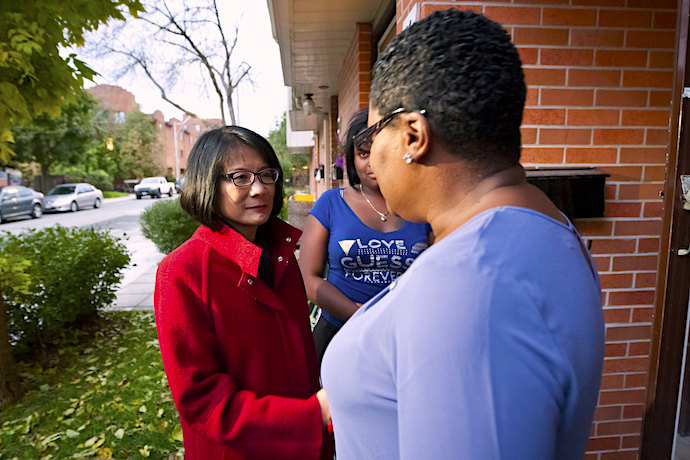After delays in tabulation that resulted from holding an election under pandemic conditions, late last month the Pew Research Center finally published its analysis of the 2020 electorate. And the results, which are derived from validated voters, should—but, if I’m being frank, probably won’t—put an end to the counterproductive focus of Democratic political operatives on courting white conservative Christians in their faith outreach efforts.
Pew found that in the 2020 election, after four years of attempts by elite commentators to dissuade them from their overwhelming Trump support, 84% of white evangelical voters pulled the lever for Donald Trump, up from 77% in 2016, according to Pew (other estimates put the 2016 figure at around 80%, though the more familiar 81% figure was the result of early exit polls). Meanwhile, 57% of white non-evangelical Protestants (i.e., mainliners) voted for Trump in 2020, a figure that remains unchanged from 2016.
President Joe Biden did win a greater share of the white Catholic vote in 2020 than former Secretary of State Hillary Rodham Clinton did in 2016 (42% vs. Clinton’s 31%), but I suspect that both Biden’s outspoken Catholic piety and the particularly misogynistic vitriol toward Clinton that pervades conservative Christian communities played a role—a gain that is, honestly, not all that impressive for someone who embraces Catholic identity as openly as Biden.
Once again, solid majorities of all white Christian demographics went to the Republican presidential candidate. Furthermore, according to a recent study published in American Political Science Review, they did so not in spite of Trump’s overt animus toward marginalized groups, but because of it. Neither the voting data nor these new findings should surprise any serious observer of American polarization, but the largely unrecognized Christian supremacy that pervades American society has hitherto represented a powerful impediment to the influence of social criticism focused on Christian demographics.
However, there are some indications that this is beginning to change, including the explicit recognition the Democratic Party has belatedly afforded to the contributions of secular Americans, which comes on the heels of burgeoning growth in the proportion of Americans who do not identify with any religious tradition, often referred to as “the nones.” In this connection, the 2020 election marks a milestone that has not yet received the attention it deserves: according to Pew’s analysis, the white evangelical share of the vote, which had held steady at around a quarter of the electorate over numerous previous election cycles, including 2018, not only dropped to 19%, but the nonreligious share of the electorate also mushroomed to 25%, topping white evangelicals’ share for the first time.
Over at The Friendly Atheist, Hemant Mehta has used these numbers to make an impassioned case that the Democratic Party should treat the nonreligious vote as a valued constituency. “Secular Americans are a reliable base for Democrats,” he writes, “yet we’re rarely ‘courted’ by candidates.” Once again, Christian supremacy is clearly the main reason why. 87% of the atheist vote went to Biden in 2020 (along with 71% of the entire religiously unaffiliated vote, which includes agnostics and the spiritual-but-not-religious). Nevertheless, atheists face severe stigmatization across much of the United States and are often found to be the least electable demographic. Still, it’s impossible to dismantle Christian supremacy by catering to it, and the numbers are now such that the nonreligious vote will be ignored at politicians’ peril, given that voter turnout among the nonreligious (though not so much among atheists) is still uneven.
But what, ideally, should the relationship between the nonreligious and the Democratic Party look like, and where does faith outreach still need to enter the picture? To address those questions, I reached out to Sarah Levin, the founder of Secular Strategies and the co-chair of the Democratic National Committee’s Interfaith Council. Making clear that she was speaking only for herself, and not on behalf of the DNC or its Interfaith Council, Levin agreed that Democratic outreach efforts should include the nonreligious, though she added, “this is a two-way street—the nonreligious need to act like a constituency to be treated like one, and the party needs to make clear that nonreligious people are welcome, along with their ideas and priorities.”
Expanding on that thought, Levin told RD:
It’s a bit of a chicken-or-the-egg situation, which is why I think progressive nonreligious activists and the party need to meet each other halfway. The party needs to provide a space for secular Democrats to feel included and valued, but secular Democrats also need to rise to the occasion—that’s where the work of secular Democrats organizing comes in: if we can deliver votes, get out a compelling and inclusive message, and start fundraising more seriously, we can provide a value proposition that no political party could turn down.
I maintain that blanket antitheism is highly counterproductive, and, although Levin didn’t say so in as many words, part of meeting the Democratic Party halfway is surely embracing pluralism, and not trying to displace core religious Democratic constituencies, such as African-American Christians. Levin, who believes that the Democrats should place equal emphasis on religious and nonreligious outreach, sees creating more space for the nonreligious and “working across differences” as a means of strengthening the Democratic Party’s big tent image.
She also observes that, with the GOP beholden to white Christian nationalists, Democrats have “an opportunity to offer a pluralistic vision that welcomes everyone,” adding, “At the end of the day, nonreligious progressives and faith-based progressives have shared values, and we’re stronger as a party when we recognize and embrace that.”
But what about those white, anti-choice Christian voters that so many Democratic strategists just can’t seem to quit? Can we finally kiss that particular brand of aggravating faith outreach goodbye? Levin says it will still be necessary in close races, when “you want to peel off votes at the margins as much as possible,” and she sees some space for reaching out to that tiny sliver of white evangelical moderates and liberals “for whom culture war issues are not the deciding factor in their vote.”
However, Levin argues, “the resources and political capital we spend on that should reflect the reality of how many of those voters are winnable.” She also contends that “what needs to change is the tendency to be overly deferential to constituencies that, overall, are not aligned with the party, while doing little to no outreach to aligned constituencies like the nonreligious.” To Levin’s strategy, I can only reply: from your lips to the ears of a God I don’t believe in.





